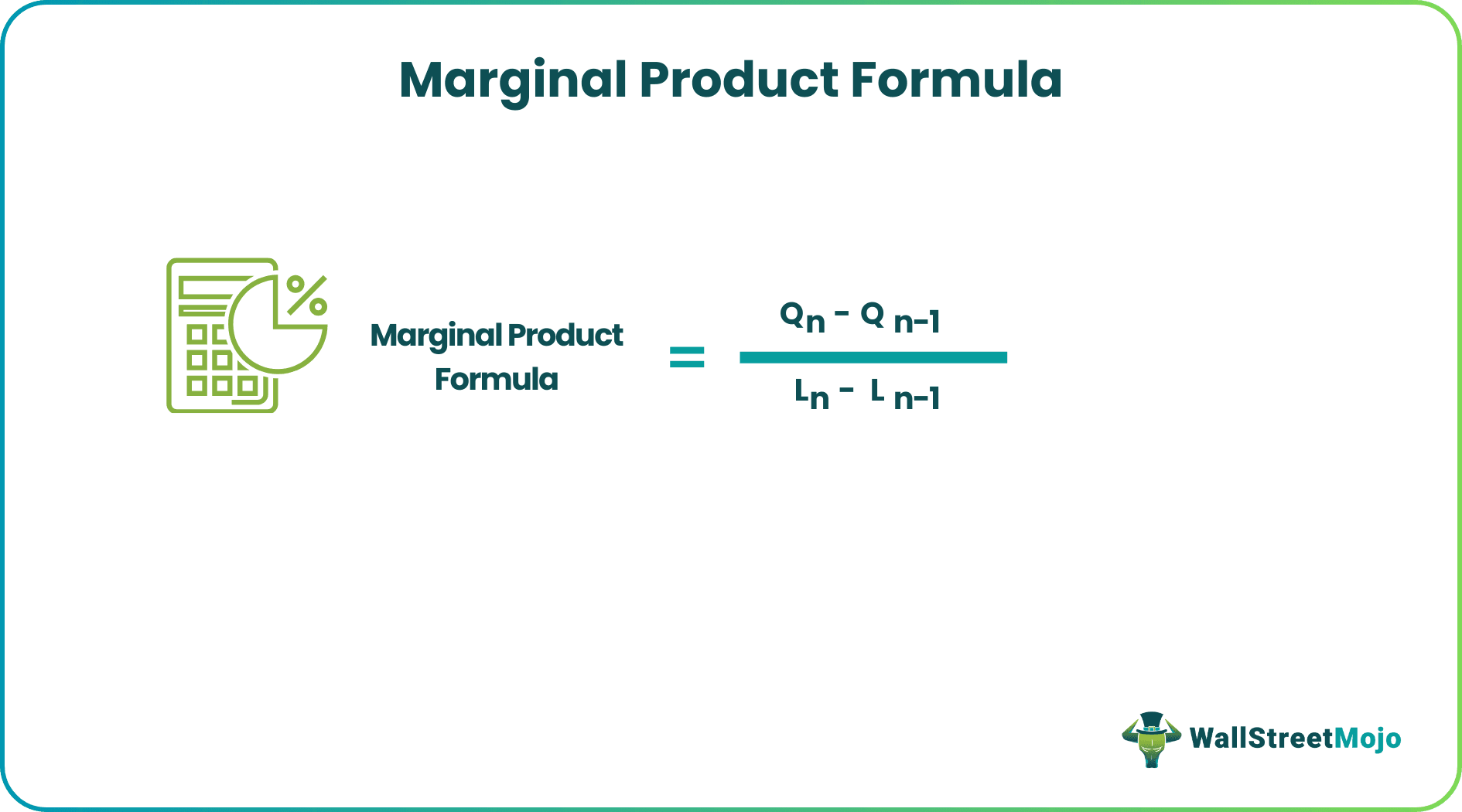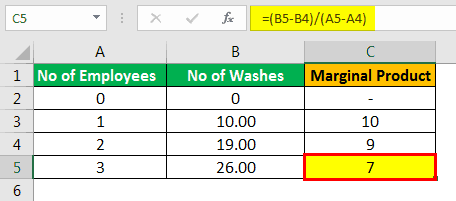Table Of Contents
What Is The Marginal Product Formula?
The Marginal Product Formula is the equation that helps find out the marginal product, which reflects the change in the number of outputs because of an extra input added to the production process. Also known as Marginal Physical Product or MPP, it helps businesses learn about the proportional change in the production volume when an input is added to the process.

One can ascertain the marginal product formula by calculating the change in quantity produced or change in production level and then dividing the same by the difference in the factor of production. Firms can also find out the marginal product by deducting the previous quantity or level of output from the current production level.
Marginal Product Formula Explained
The marginal product formula helps calculate an increase in total production of a factor of production (capital, labor, land, etc.), resulting from the increase in one unit in the factor of production. In contrast, other factors of production are kept constant.
The factors of production are the support system that facilitates the whole production process. These can be anything from mechanical input to labor forces utilized for the production of each unit of an item.
For example, a bakery shop produces X units of items every day. However, seeing its popularity and enhanced sale of products, it adds one unit of baking apparatus along with 10 more laborers to meet the demand. This addition leads to an increase in the number of units the bakery shop produces every day, making it X+50 units.
Using the marginal product formula, the bakery shop can easily find out the change in the number of items produced because of the addition of the new factors of production. This, in turn, would help it understand the changes to be made in the factors of production per the rising demand in the market.
How To Find Marginal Product?
The Marginal Product (MP) formula that is used to calculate the change in the output is mentioned as follows:
When,
- Qn is the Total Production at time n
- Qn-1 is the Total Production at time n-1
- Ln is the Unit at the time n
- Ln-1 is the Unit at time n-1
The denominator in most cases is one as the formula that was initially made was based on every 1 unit of increment in an aspect of production.
Examples
Let us consider the following examples to understand the concept and the application of this formula in a better manner:
Example #1
QRP Ltd. is a small shop and is in the business of washing the clothes for their customers. QRP Ltd. wants to hire more employees to grow its business.
Below are the details of the output and number of employees:
| No of Employees | No of Washes |
|---|---|
| 1 | 10.00 |
| 2 | 19.00 |
| 3 | 26.00 |
You are required to compute the marginal product based on the above information.
Solution:
When 2 employees are hired,
Therefore, the calculation of marginal product is as follows:

= (19 – 10) /(2 – 1)
Marginal Product will be -

- Marginal Product = 9
When 3 employees are hired,
Therefore, the calculation of marginal product is as follows:

= (26 – 19) /(3 – 2)
Marginal Product will be -

- Marginal Product = 7
Example #2
VSP White Rock is fund management and asset management company. Their managers are widely known for generating alpha and providing better returns than the market. Hence, most institutional investors' choice is VSP White Rock, and even retail individuals have started investing in this fund heavily. However, within the past few months, the returns have been reduced by 10 basis points within the past few months. Below is the monthly summary for the returns of one of the schemes, “SMC,” that they have generated.
| Investment Amount (million) | Returns |
|---|---|
| 0 | 0.00 |
| 100 | 15.89% |
| 200 | 16.11% |
| 300 | 16.34% |
| 400 | 16.58% |
| 500 | 16.83% |
| 600 | 17.09% |
| 700 | 17.30% |
| 800 | 17.48% |
| 900 | 17.56% |
| 1000 | 17.56% |
The team wants to analyze whether the funds need to be paused in "SMC" and instead create a new pool called "SMC 2" so that returns do not vanish.
You must calculate the Marginal Product of Capital returns and advise whether one should create the new fund?
Solution
Here the managers are worried about more inflow of funds, and their returns are diminishing.
When 200 million were invested,
Therefore, the calculation of marginal product is as follows:

= (16.11% – 15.89%)/(200 – 100)
Marginal Product will be -

- Marginal Product = 0.0022%
When 300 million was invested,
Therefore, the calculation of marginal product is as follows:

= (16.34% – 16.11%)/(200 – 100)
Marginal Product will be -

- Marginal Product = 0.0023%
Similarly, we can calculate till 1000 million was invested.

As seen from the above table, when more funds were invested, the marginal product of returns started diminishing. As a result, the managers lacked the opportunity to invest as most of their ideas would be sufficiently invested. Therefore, they should create a new pool of funds called “SMC 2.”
Example #3
B&B Bros. manufactures product 'X,' which requires a lot of labor. Hence, they have hired almost 10-15 laborers per week. Below are the details of output and number of employees: -
| Labor Hired | Production (Kilo) |
|---|---|
| 0 | 0 |
| 12 | 1000.00 |
| 21 | 2000.00 |
| 29 | 29000.00 |
| 35 | 3950.00 |
| 41 | 4880.00 |
| 51 | 5770.00 |
| 62 | 6600.00 |
| 74 | 7500.00 |
The management is concerned with the wages hike and their cost. Hence, they want to determine the optimal production level and lay off the extra work.
You are required to calculate the Marginal Product of labor and advise accordingly.
Solution
When they 21 hired laborers,
Therefore, the calculation of marginal product is as follows:

= (2,000 – 1,000)/(21 – 12)
=1,000 / 9
Marginal Product will be -

- Marginal Product = 111.11
When 29 labor was hired
Marginal Product will be -

=(2,900 – 2,000)/(29 – 21)
= 900 / 8
- Marginal Product will be = 112.50
Similarly, we can calculate till they hired 74 employees.

We can see from the above table that the optimal production level is when 35 laborers are hired. Post that, the marginal product started diminishing. Hence, the management can lay off anything above 35 to 41 laborers.
Relevance and Uses
To know how calculating the marginal product helps entities, let us have a quick look at the following points:
- It allows firms to check for the increase in production level per one unit of a factor of production added.
- The definition of one factor of a production unit can vary by firm. The objective for the firm is to search for the optimal level of several employees (the type of factor of production) it must hire to achieve maximum revenue and output.
- Too few laborers shall mean they are not very productive. But, on the other hand, several laborers could mean they spend more on wages than the output they are bringing in. Hence, both situations are an issue for any business that is growing.
In short, the marginal product formula, when applied, helps businesses assess their position in the market.

